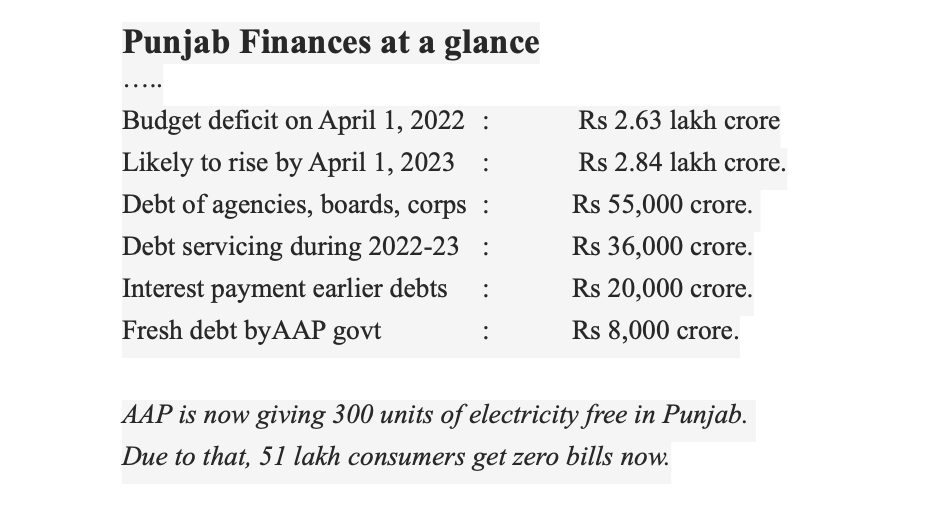A fortnight ago, on August 15, Punjab Chief Minister Bhagwant Mann announced the opening of 75 Mohalla Clinics in the state.
Aam Aadmi Party (AAP) government of Arvind Kejriwal had started this scheme in Delhi, with Mann claiming that it was a “very successful’’ initiative. Impressed by Delhi government’s implementation of the scheme, he said that the Punjab government was committed to opening many more of these Mohalla clinics.
Besides, AAP had announced during the legislative assembly elections in Punjab some months ago that it will provide up to 300 units of electricity for free. It was committed to implementing this scheme and at least 51 lakh households will start getting zero electricity bills.
That can only mean losses for the exchequer and makes little economic sense.
Both the Mohalla Clinics and free electricity are concepts imported into Punjab from Delhi. It is literally replication of two schemes that Kejriwal pioneered in Delhi with huge political dividends. But beyond the fact that both Delhi and Punjab today have AAP governments, are the two states comparable? Well, perhaps a comparison between finances of Delhi and Punjab can help us draw our own conclusions.
At a cursory glance, Delhi is a semi-state with a surplus budget. Punjab, in contrast, is a full-fledged state with a huge budget deficit. By April 1 this year—end of last fiscal year—it owed a debt of Rs 2.63 lakh crores. This will continue its northward march. By the end of financial year 2022-23, it is expected to rise to Rs 2.84 lakh crore. Besides, various state agencies, boards and corporations have a debt of Rs 55,000 crore.
The figures of debt servicing for Punjab are daunting as it would pay over Rs 36,000 crore this year, of which more than Rs 20,000 crore will be interest payments alone! To take the discussion about the financial health of Punjab, it needs to be stated here that it has already taken a debt of Rs 8,000 crore ever since AAP government has come to power.

In the near future, the states and Union Territories (UTs) where elections are due include Himachal Pradesh, Gujarat and UT of Jammu and Kashmir, AAP is trying to make inroads in all these three places, ruled by BJP, directly or indirectly. No prize for guessing that in all these places, it is promising a replication of Delhi model of development, promising freebies left, right and centre.
With only a few months left for polls in Himachal now, Chief Minister Jai Ram Thakur started treading the path of AAP in some ways. On Monday, Thakur announced that as a welfare measure, his government is now offering 125 units of electricity free to households. This has benefited over 14 lakh consumers, he said, adding his government will offer 50% concession to women in roadways buses.
These measures seem eerily similar to AAP initiatives taken in Delhi, though tampered and toned down. Prime Minister Narendra Modi had denounced the culture of freebies, targeting Kejriwal and terming it “revdi baantna’’.
The pitfalls of offering freebies became clear a couple of years in Venezuela, but that part of world is so far away, we hardly ever discussed what happened to citizens there. Very recently, we saw what offering freebies can do to an economy as our southern neighbour Sri Lanka faced a meltdown. Ferocious floods in Pakistan have drawn our attention away from the economic crisis for the time being. Otherwise, instead of this humanitarian crisis, we would have been more closely scrutinising Pakistan’s economic woes and tanking of its economy, much in the manner of Sri Lanka.
In Gujarat also, Kejriwal is trying to emerge as the alternative to Congress, in severe disarray, and facing its first assembly election after the death of Gandhi loyalist Ahmed Patel. Since 2001, the BJP has been the ruling party in the state though the party’s dominance had started from 1995. It faces a daunting task of beating incumbency of 21 years (plus) and even a small loss here in assembly elections will get magnified. More so, because of the dominant duo in the BJP, Modi and Amit Shah, both come from Gujarat.
Incidentally, Gujarat is counted as a development story scripted by Modi and replicated elsewhere in other states and at national level. However, Kejriwal is trying to introduce new issues in Gujarat and is beginning to be a headache for the BJP leaders there. On Wednesday, AAP started a statewide campaign in Gujarat to educate the voters about “guarantees’’ offered by Kejriwal. The campaign was led by Gujarat AAP chief Gopal Italia, and unlike Sonia Gandhi (nee Maino), he has no Italian connection. In a couple of days, Kejriwal is expected to arrive in the state to give momentum to the month-long campaign.
AAP has made several pre-poll promises in Gujarat, including free electricity of up to 300 units per month, a la Punjab, unemployment allowance, creation of 10 lakh new jobs, free and quality healthcare and a Rs 1,000 allowance for woman. Incidentally, in Punjab also, the party had made the announcement regarding Rs 1,000 allowance for woman but it remains unimplemented so far.
An interesting strategy AAP has adopted to take on BJP’s Hindutva plank is choosing Ganesh Chaturthi day for launching its campaign in Gujarat. Taking it a step further, Kejriwal is expected to arrive for the campaign in Dwarka on September 2, considered Devbhumi identified with Shri Krishna. These two are but smallest of seemingly imperceptible but potent symbols of Hindutva AAP seems keen to appropriate.
In popular western literature, mainly folklore, witches are seen practising their trade, witchcraft, riding on brooms. In many western movies too, powerful witches vroom from place to place on brooms. AAP has already risen to power in two states in the last decade riding on its symbol of jhaaru (broom). It remains to be seen how far jhaaru can carry Kejriwal and his ambitions.
(Sant began as a teacher but after six years, joined the Indian Express, Chandigarh in 1990, the year when terrorism was taking its first step in J & K and soon there would be exodus of lakhs of Kashmiri Pandits from the Valley. He subsequently worked for The Statesman, The Times of India and Star News among others. He is based in Jammu since May 2000. He edits epaper.earthnews.in, a newspaper from Jammu presently.)


